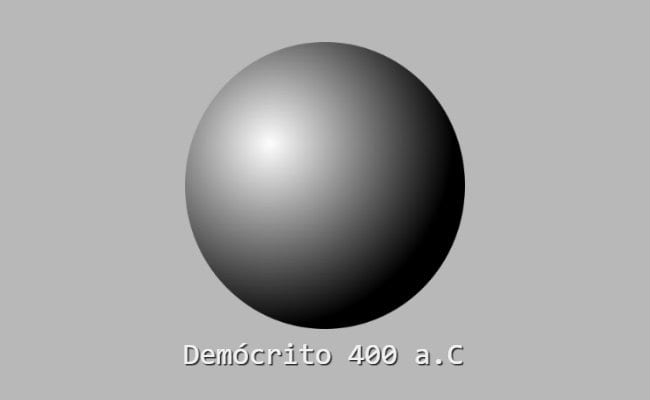An atomic model is a way of represent the structure of atoms, which in turn tries to explain the way in which they behave and their properties, throughout the entire history of mankind, there have been several of these models, but the first philosopher to postulate one of these was Democritus, who considered the atom to be the smallest particle of matter, which was indivisible and indestructible.
Known as the philosopher who laughs, due to the fact that in most of his portraits he is found with a big smile, he was a pre-Socratic Greek philosopher and mathematician who lived between 460 and 370 BC between the XNUMXth and XNUMXth centuries BC.
Who is Democritus?
In his time he was known with nicknames such as Milesa and Abderita, born in the city of Abdera (Thrace) a city of the Greek polis north of the mouth of the Nestos river, which was near the island Thasos, the name Democritus translates to Spanish as the one chosen by the people, he was born in 460 BC, and began his apprenticeship during the medical war against the Greeks, where he learned about theology and astrology, at a very young age.
Despite the fact that he was contemporary with Socrates, he is considered a pre-Socratic philosopher, which is a complete error, although he had a physis theme, while Socrates followed an ethical-political style, which differentiated him from the philosophers of the time.
Democritus was the main disciple of Leucippus, who later became his successor, both being from the same land, and sharing many teachings, they managed to structure an atomic model that to this day is very useful, despite having more than 2 millennia old.
He was a born traveler, and he undertook a journey through many different cities and cultures, learning from the Persian and Egyptian magicians where he obtained knowledge of all those communities, and even legends were told about him, such as one that says that he gouged out his eyes so that they will not interfere with your meditation.
He lived until 370 BC, died at the age of 90, although many agree that this flamboyant philosopher achieved a life greater than 100 years of age.
Throughout his life he was totally ignored by the people of Athens, although he was recognized by the great Aristotle, who always commented that he did not obtain enough fame, because he was not interested in achieving it, and Socrates never knew him, although he did I get to know him.
Due to his constant laugh, which he said he performed as irony at the direction the world was taking, he was known as the laughing philosopher, or the smiling Abderita, which can be seen in his different portraits, and he managed to be the opposed to Heraclitus who was known as the crying philosopher, reflecting a totally different attitude.

What is the atomic model of Democritus?
Being the first atomic model postulated by a Greek, Democritus managed to develop together with his teacher Leucippus, the atomic theory of the universe, which was not developed like the current models through experiments, but rather, with logical reasoning and although the one that mainly the performed was his teacher, it is very difficult to differentiate them, since they are very similar.
In his model he schematized that atoms are homogeneous, eternal and indivisible and in turn are invisible and incomprehensible, as well as they are not differentiated by their internal characteristics, but by their shapes and sizes. Everything that understands the form of matter depends on the atoms that make it up.
The name atoms was given by himself, which is a Greek expression which translates as those that cannot be counted, which are original elements that possess the qualities of immutability and eternity, which due to their tiny size cannot be perceived by human senses.
Democritus working together with his mentor Leucippus, they determined that the movement is a real fact, which gave rise to the force and inertia that are used in physical experiments to this day, such thought was of those followers of the atomist movement, while the Eleatas did not accept this as a reality.
Son had that the atoms came together due to their different shapes, although between them there was a small amount of space which allowed to distinguish between them, and their diversity, they only divided for a certain period of time, caused by the collision between them and another set of atoms, which did not last long, because they would soon be reunited with others, forming a new body.
Movement in atoms is a natural process, they will always be moving in space, perhaps changing their position, but never destroyed, maintaining their shape throughout eternity, seeking to be part of a set of them, as long as possible.
All existing beings and objects in the universe are made up of sets of atoms, which collide with each other to form their bodies and forms, although most maintain that this fact is a matter of chance, in the atomic model of Democritus, this arises by a need for union between them, these models comprise a totally materialistic thinking, in the sense that everything formed and created is a matter of chance and chain reactions of these small particles that make them up.
These atoms are what convey the appearance that can be observed, and even provide the ability to perceive and feel. Democritus argued that the human mind was made up of light and spherical atoms, while the body was made up of heavier and stronger atoms, just as these are the ones who acquired knowledge and those who had the ability to feel everything that is present. around it.
Philosophers like this laughing Abderita, postulated their models based on logical reasoning and thinking, they never did it with sensory experiences or experiments. Democritus in his model, hinted that bodies are made up of only two elements, the atoms that give shape to them, and the void between them.